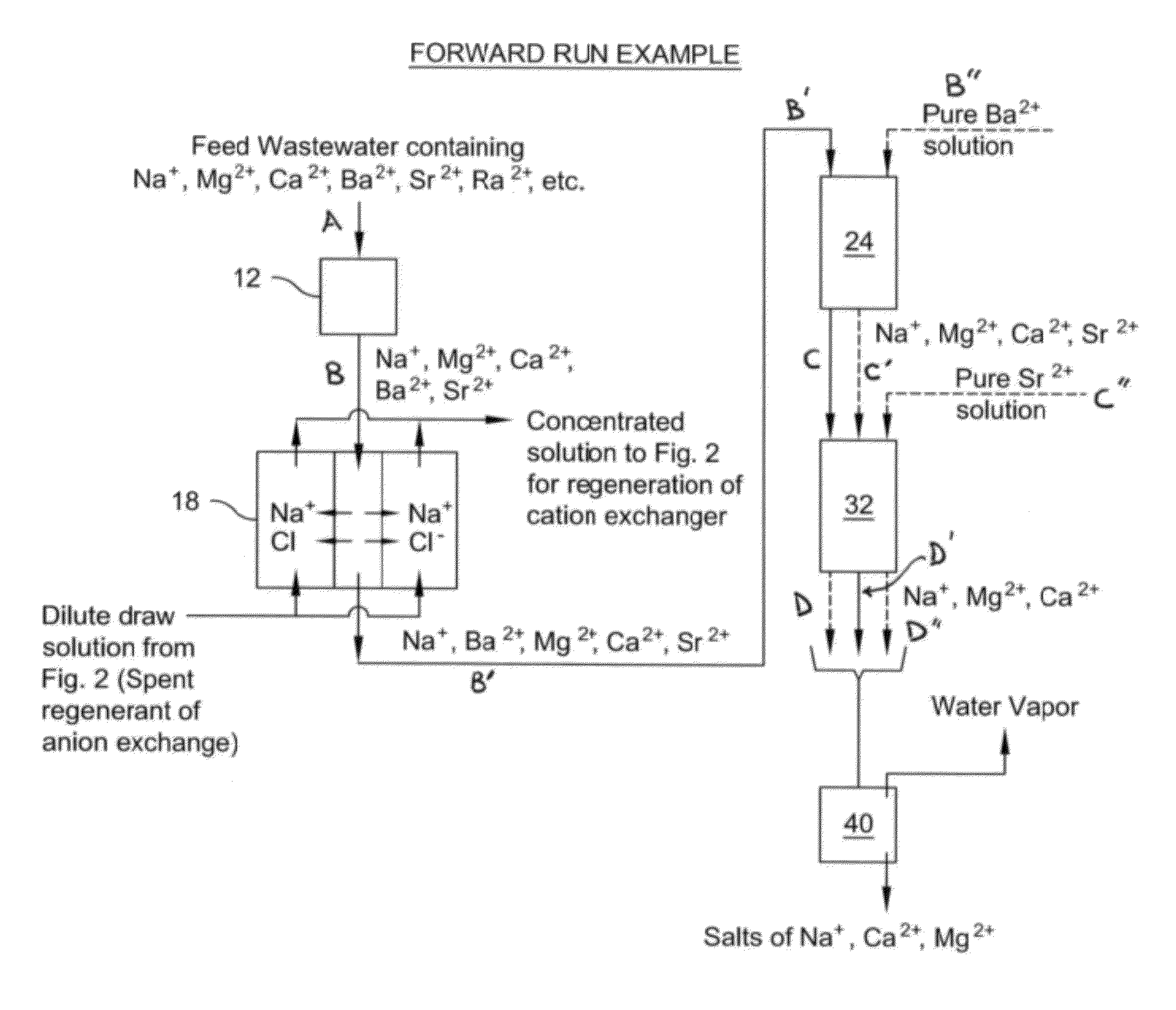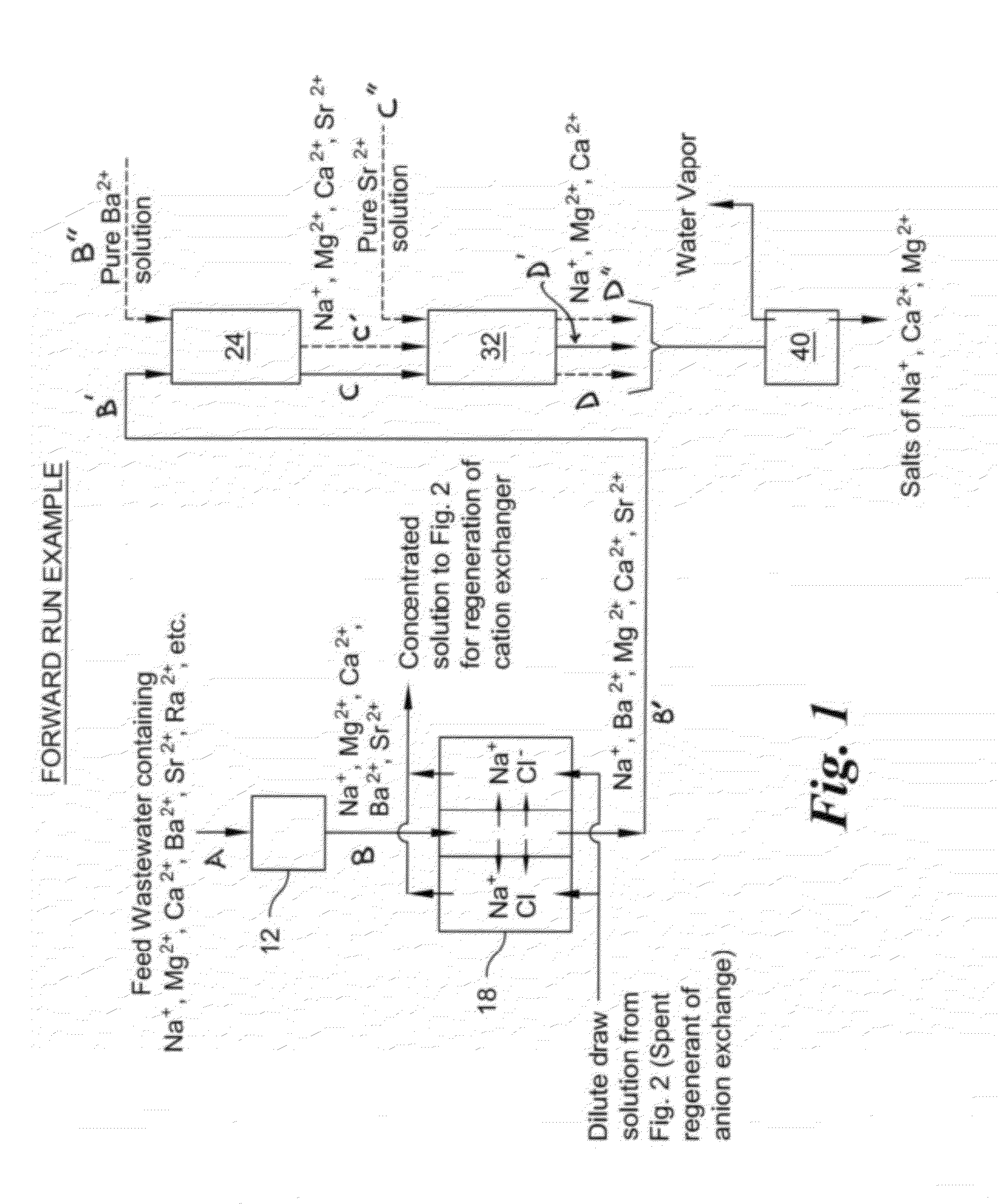Method of treatment of produced water and recovery of important divalent cations
a technology of divalent cations and produced water, which is applied in the nature of treatment water, waste water treatment from quaries, and separation processes, etc., can solve the problem of high volume of wastewater with dissolving solids
- Summary
- Abstract
- Description
- Claims
- Application Information
AI Technical Summary
Benefits of technology
Problems solved by technology
Method used
Image
Examples
example 1
[0043]The radium removal step of the Marcellus wastewater treatment process using selected dose of hybrid radium selective ion exchanger (HRSX), as previously mentioned herein, was validated in the laboratory using wastewater obtained from Covington Unit #1 of Marcellus gas field, PA. The raw wastewater with a pH 5 was adjusted to neutral pH using 1M NaOH solution and subsequently the sample was filtered to get rid of suspended particles and dissolved iron. The filtered sample thus obtained was further contacted in batches with 2 g of HRSX (prepared from C-145 using the 4 step methods previously described herein) for 500 mL sample volume, i.e., a dosage of HRSX of 4 g / L was maintained. FIG. 3B shows enlarged view of the HRSX synthesized from cation exchange resin with polystyrene matrix and sulfonic acid functional group, identified as “C-145” (manufactured by Purolite Inc., Philadelphia, Pa., USA) which is shown in enlarged view in FIG. 3A. Both the wastewater samples before and af...
example 2
[0045]The wastewater after radium removal was subjected to anion exchange reactor described in FIG. 5. The draw solution used on the other side of the membrane had a concentration of 2000 ppm NaCl. The anion exchange membrane was procured from M / s Asahi Kashei Corporation, Japan. The anion exchange membrane type had the following characteristics; a) Model: NEOSEPTA ACS; b) electrical resistance: less than 3.8 ohm-cm2 when measured with 0.5 N NaCl; c) burst strength: greater than 0.15 MPa; d) thickness: 0.13 mm e) functional group; quaternary ammonium. The contact time provided was about 90 hours. Table-4 below provides the distribution of different cations before and after the experiment.
TABLE 4Distribution of different cations before and aftertreatment at anion exchange membrane reactorInitial conditionFinal conditionFinal conditionNamein Wastewaterin wastewaterin draw solutionof(Compartment#2)(Compartment#2)(Compartments #1 or 3)cation(meq / L)X(meq / L)X(meq / L)xNa+19830.698800.571209...
example 3
[0047]In a regeneration process, solutions containing strontium and barium ions in the background of high concentration of sodium ions with smaller concentrations of calcium and magnesium ions are recovered. Strontium and barium are obtained from the recovered solutions as their sulfate salts. When passed through anion exchanger beds in sulfate form, chloride ions in the solution are exchanged for sulfate ions. Extraction of pure salts of strontium and barium sulfate is contingent upon precipitation of pure salts separate from precipitation of sulfate salts of other impurities such as calcium or magnesium present in the wastewater. To the wastewater, 0.1M solution of sodium sulfate was added continuously and the concentration of divalent ions such as barium, strontium and calcium in the supernatant was continuously monitored. Concentration of divalent ions in the solution phase decreases due to the precipitation of their sulfate salts. FIG. 6 shows the percentage precipitation of th...
PUM
| Property | Measurement | Unit |
|---|---|---|
| concentration | aaaaa | aaaaa |
| lateral length | aaaaa | aaaaa |
| pressure | aaaaa | aaaaa |
Abstract
Description
Claims
Application Information
 Login to View More
Login to View More - R&D
- Intellectual Property
- Life Sciences
- Materials
- Tech Scout
- Unparalleled Data Quality
- Higher Quality Content
- 60% Fewer Hallucinations
Browse by: Latest US Patents, China's latest patents, Technical Efficacy Thesaurus, Application Domain, Technology Topic, Popular Technical Reports.
© 2025 PatSnap. All rights reserved.Legal|Privacy policy|Modern Slavery Act Transparency Statement|Sitemap|About US| Contact US: help@patsnap.com



